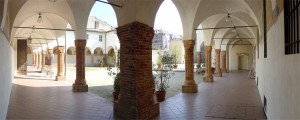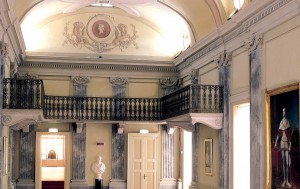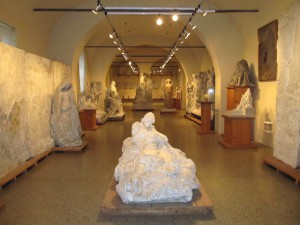Ex Convento di Santa Croce – Museo Civico (UK)
Period: The Convent is an adaptation of the original building built by the religious Order of the Humiliated. It was given to the Augustinian monks after the middle of the fourteenth century
Present Use: It has been the seat of the Civic Museum since 1995
The Courtyard: The construction originally leant against the surrounding wall erected by the municipality during the thirteenth century. In the last quarter of the fifteenth century the Convent was extended to add a new dormitory as well as the refectory, kitchen and pantry, which today houses the gipsothèque. It was probably then that the grand cloister was built where the columns covered in grooved terracotta can still be seen today.
At the beginning of the seventeenth century the walls of the grand cloister were embellished with frescoes of stories of Saint Nicola da Tolentino while the small cloister with stories of the Blessed Giovanni Bono, both works of Guglielmo Caccia also known as il Moncalvo, in collaboration with Giorgio Alberini
The Interior: The nine stories, removed in 1916 from the north wall and transferred on canvas, are today preserved in the hall of the Lunette in the Civic Museum. This hall has a coffered ceiling dating back to the sixteenth century and was originally the refectory of the convent. On the first floor, the former chapter house of the convent bears the name of the Spoletino architect Agostino Vitoli who was also responsible for the rebuilding, commissioned by the Augustinian fathers, in 1787. Along the route visitors can also see the rooms and monastic cells occupied by the monks during their stay which ended at the beginning of the nineteenth century
The Civic Museum: It has three sections – the art gallery which has a rich display of paintings, sculptures and ceramics, the gipsothèque with over 170 sculptures in plaster, marble and bronze by the symbolist Casalese artist Luigi Bistolfi and the Archeology Hall. The splendid portal, dating back to the fifteenth century and belonging to the former Church of the Holy Mary of Piazza, is in the small cloister


